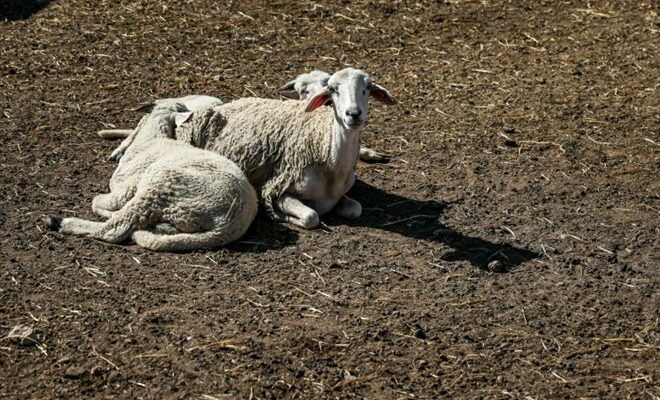A farmer inspects his drought-affected grain field on February 7, 2024 in Berrechid, in the historically wheat-rich province, southeast of Casablanca, Morocco (AFP/FADEL SENNA)
“The harvest is already lost.” Abderrahim Mohafid has little hope of saving his wheat production this year, due to the scarcity of rains which is pushing Morocco into its sixth consecutive year of drought.
On the road leading to his hamlet in Berrechid province, southeast of Casablanca, the vast fields are unusually bare.
In this agricultural area renowned for being the country’s grain basket, “the wheat should already be at 60 centimeters” at this time, notes Mr. Mohafid, 54, bitterly, surveying his 20 hectares where almost nothing has grown.
A few kilometers from his hamlet of Oulad Mbarek, Hamid Najem is in the same situation. His 52 hectares of soft wheat and barley “are no longer good for anything”.
“We have never experienced such a hard year,” alarms this fifty-year-old.
More than 88% of the 155,000 hectares of agricultural land in this province are not irrigated and the majority of farmers there therefore depend on rain, according to the Ministry of Agriculture.

A shoot of cereals in a field affected by drought, February 7, 2024 in Berrechid, southeast of Casablanca, Morocco (AFP/FADEL SENNA)
But since the beginning of January, the kingdom has recorded rainfall down 44% compared to the start of 2023, with at the same time an average increase in temperatures of 1.8 degrees compared to the period of 1981-2010, the Minister of Agriculture recently indicated. ‘Water, Nizar Baraka.
The dams are only 23% full, compared to around 32% last year, and faced with the risk of shortages, the Moroccan authorities have in recent weeks restricted the opening of hammams and car wash stations in several cities, or banned watering golf courses and gardens with drinking water.
– “Serious impact on the economy” –
This sixth year of drought “compromises” the agricultural season, warns agronomist Abderrahim Handouf.
Farmers, who feared this new episode, had already reduced the area sown with cereals in November (2.3 million hectares sown compared to four to five million hectares on average in previous years), he explains to the ‘AFP.

A farmer installs a drip watering system in a potato field on February 7, 2024 in Berrechid, southeast of Casablanca, Morocco (AFP/FADEL SENNA)
According to the agronomist, this situation will have a “serious impact on the economy”, in a country where agriculture employs a third of the population and represents 14% of exports, more profitable than the local market.
This year, Abderrahim Mohafid hoped to make up for the difficulties accumulated in previous seasons by adopting the direct sowing technique consisting of sowing without prior plowing of the land, which allows it to preserve its natural humidity.
“The harvest is already lost but I hope it will rain in February and March to at least have enough to feed the livestock,” he confides.
The outlook is less gloomy for large farmers like Hamid Mechaal, who can count on irrigation to save his 140 hectares where he grows wheat, carrots and potatoes, in the east of the province of Berrechid.
“With the drought, we are forced to irrigate at 85% whereas before, irrigation was only complementary,” notes the farmer, who assures that he is supplied, like 500 farmers in the region, by a fixed allocation of 5,000 tonnes of water per hectare “to better manage” the precious resource.
– “Review” agricultural policy –
The Food and Agriculture Organization of the United Nations (FAO), however, was alarmed by a “disorderly intensification of irrigation” in the Berrechid plain over the past two decades.

Sheep in a grain field affected by drought, February 7, 2024 in Berrechid, southeast of Casablanca, Morocco (AFP/FADEL SENNA)
“Between 2007 and 2017, the production of carrots, for example, jumped by almost 500%,” she noted in a November report, emphasizing that the aquifer was “one of the most degraded ” from the country.
The Moroccan agricultural model, focused for 15 years on exports, once again raises questions knowing that the country is facing “an absolutely declining water supply” and that it has focused on water-intensive crops, notes the agronomist Mohamed Taher Srairi.
National needs are estimated at more than 16 billion m3 of water, including 87% for the agricultural sector, but only five billion have been available over the last five years, according to Mr. Baraka.
For agronomist Abderrahim Handouf, “agricultural policy should be reviewed from top to bottom”.
“Today, I have the impression that the government is looking in one direction while the reality is in the opposite direction,” he regrets.
© 2024 AFP
Did you like this article ? Share it with your friends using the buttons below.




